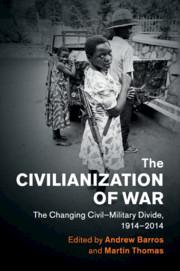Book contents
- The Civilianization of War
- Human Rights in History
- The Civilianization of War
- Copyright page
- Contents
- Tables
- Contributors
- Acknowledgements
- Introduction: The Civilianization of War and the Changing Civil–Military Divide, 1914–2014
- Part I Who Fights? Combatants, Mobilization and the Changing Nature of War
- Part Ia The ‘Total War’ Era, 1914–1945
- Part Ib The Cold War and Decolonization, 1945–2000
- 4 The Collapsing Civil–Military Divide in Wars of Decolonization: Two Case Studies from the Indochina War (1945–1954)
- 5 Parallel Ambiguities: Prisoners during the Algerian War of Independence
- 6 East Pakistan/Bangladesh 1971–1972: How Many Victims, Who, and Why?
- 7 ‘I Wasn’t a Boy, I Was a Soldier’: Militarization and Civilianization in Narratives of Child Soldiers in Africa’s Contemporary Conflicts, c.1990–2010
- Part II A Moving Target: Strategic Bombing and Civilians, 1916–2014
- Part III Civilian Protection and International Norms and Organizations: When and How Much?
- Index
4 - The Collapsing Civil–Military Divide in Wars of Decolonization: Two Case Studies from the Indochina War (1945–1954)
from Part Ib - The Cold War and Decolonization, 1945–2000
Published online by Cambridge University Press: 20 July 2018
- The Civilianization of War
- Human Rights in History
- The Civilianization of War
- Copyright page
- Contents
- Tables
- Contributors
- Acknowledgements
- Introduction: The Civilianization of War and the Changing Civil–Military Divide, 1914–2014
- Part I Who Fights? Combatants, Mobilization and the Changing Nature of War
- Part Ia The ‘Total War’ Era, 1914–1945
- Part Ib The Cold War and Decolonization, 1945–2000
- 4 The Collapsing Civil–Military Divide in Wars of Decolonization: Two Case Studies from the Indochina War (1945–1954)
- 5 Parallel Ambiguities: Prisoners during the Algerian War of Independence
- 6 East Pakistan/Bangladesh 1971–1972: How Many Victims, Who, and Why?
- 7 ‘I Wasn’t a Boy, I Was a Soldier’: Militarization and Civilianization in Narratives of Child Soldiers in Africa’s Contemporary Conflicts, c.1990–2010
- Part II A Moving Target: Strategic Bombing and Civilians, 1916–2014
- Part III Civilian Protection and International Norms and Organizations: When and How Much?
- Index
Summary
- Type
- Chapter
- Information
- The Civilianization of WarThe Changing Civil–Military Divide, 1914–2014, pp. 82 - 99Publisher: Cambridge University PressPrint publication year: 2018



